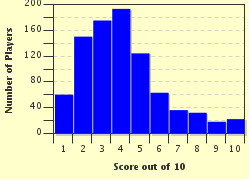Quiz Answer Key and Fun Facts
1. ONE! What is this ONE structure that is attached to the cecum of the large intestine?
2. TWO! What are the TWO structures in the ear that are responsible for sense of linear and circular motion (vestibular system)?
3. THREE! What are the THREE subdivisions of the brain stem?
4. FOUR! What are the FOUR parts of the fallopian tube?
5. FIVE! The word "scalp" is actually a FIVE-layered structure covering the cranium (bone protecting the brain). "S" stands for skin. "C" stands for connective tissue. "A" stands for aponeurosis. "L" stands for loose areolar connective tissue. What does "P" stand for?
6. SIX! At around SIX months of age, infants' deciduous teeth or milk teeth come out. Which milk teeth first come out at this age?
7. SEVEN! In which region of the vertebral column can you find SEVEN vertebral bones?
8. EIGHT! The wrist is composed of EIGHT carpal bones. Which bone below is one of the eight carpal bones?
9. NINE! The pituitary gland, as a whole secretes NINE hormones. The pituitary gland, can also be divided into the anterior pituitary and the posterior pituitary gland. Which among the nine hormones can be found in the posterior pituitary gland?
10. TEN! The TENTH cranial nerve is the vagus nerve (CN X). The vagus nerve provides both motor and sensory innervations to several organs and structures. Which organ is NOT supplied by the vagus nerve?
Source: Author
AlvarezMD
This quiz was reviewed by FunTrivia editor
crisw before going online.
Any errors found in FunTrivia content are routinely corrected through our feedback system.


